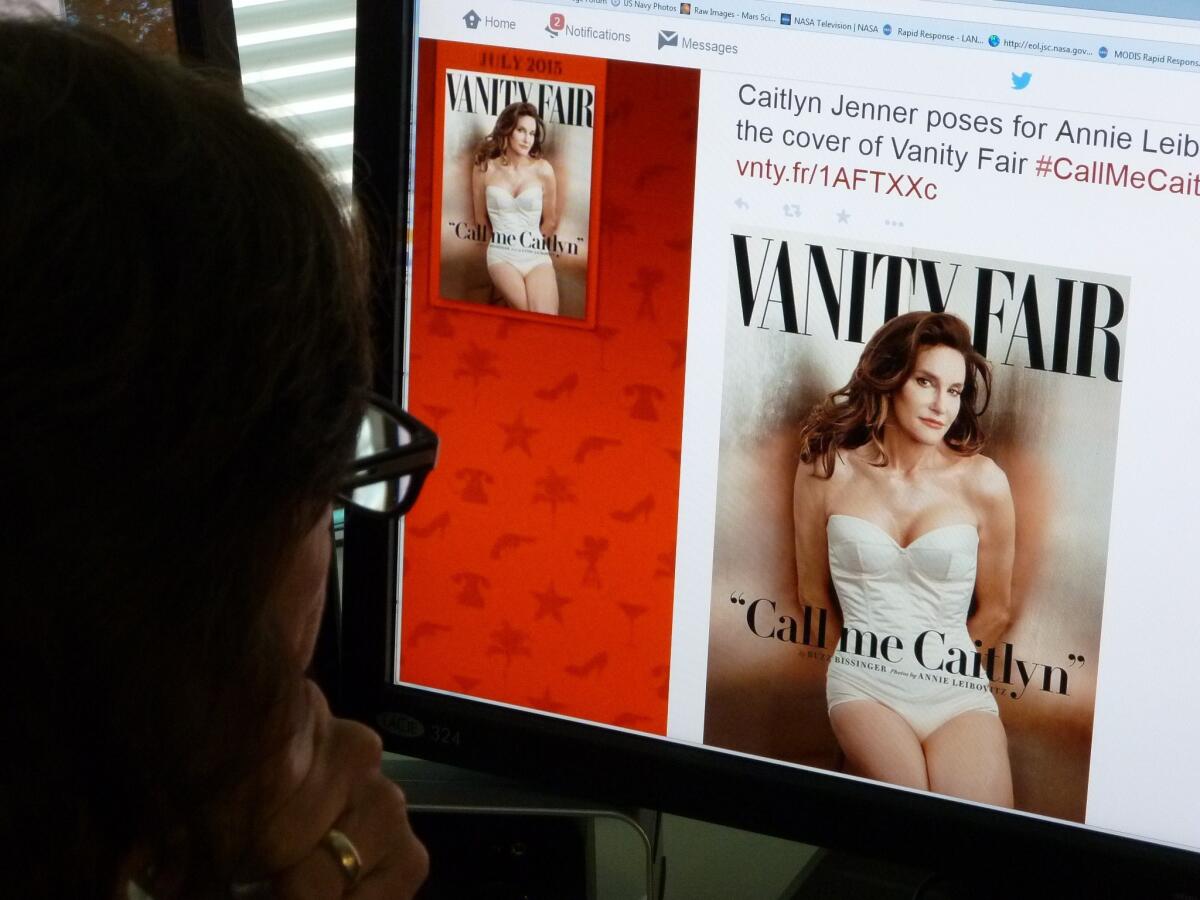Critic’s Notebook: Caitlyn Jenner’s courage is bold, Annie Leibovitz’s portrait cliched

A journalist looks at Vanity Fair’s tweet about Caitlyn Jenner, who will be featured on the magazine’s July cover. Caitlyn Jenner, the transgender Olympic champion formerly known as Bruce, on Monday unveiled her new name and look in a Vanity Fair cover shoot.
- Share via
The Annie Leibovitz photograph of Caitlyn Jenner slated for the July cover of Vanity Fair — prime magazine real estate — was revealed Monday. The trumpeted publicity still is the latest and, in some ways, most dramatic step in the difficult gender transition of former Olympic decathlon gold medalist Bruce Jenner.
For wardrobe, Betty Grable’s ‘40s bathing suit is crossed with Madonna’s white-satin ‘90s bustier. Toss in the gold-ground setting from a Byzantine icon that Andy Warhol chose for his silk-screen version of Marilyn Monroe’s famous publicity still from the 1953 Hollywood potboiler “Niagara.”
Add a glamorous, cascading hairstyle lifted from somewhere between Rita Hayworth’s smoking Gilda and Bette Davis’ fearsome Margo Channing. And — voila! — a pinup for the age of Pinterest.
For all the advance buildup, the picture feels flat — a pedestrian celebrity pastiche of rather tired visual cliches. That’s too bad. Jenner’s courage in taking control of the public process of coming out as transgender is bold, and this will be the most widely seen initial image.
In recent years, the LGBT civil rights movement has been making huge strides. It has taken decades, but transgender men and women are now an essential part of the necessary equality mix. Jenner, by effectively stage-managing her transition, has largely avoided what could have been a cruel and ugly scenario.
Yet the Vanity Fair photograph seems a missed opportunity — a picture from the past rather than the present. Maybe that’s because all its conventional, glamour-girl signals weigh down the lively fluidity swirling at the center of gender identity.
Leibovitz and Jenner, photographer and subject, are both 65. They were raised in an era when gender ideas were more stable, fixed and binary than they are today.
In 1991, Los Angeles photographer Catherine Opie blew up those inflexible conventions in a now famous suite of 13 color photographs titled “Being and Having.” The artist shot tight, close-up portraits of lesbian friends against screaming yellow backgrounds. Each suddenly ambiguous face sports an exaggerated mustache, beard, sideburns or other masculine props — tattoos, piercings, a do-rag or shades.
Fakery and play mingle with authenticity and solemnity. In these iconic images, identity is a question, not an answer. Homosexuality unfolds as something marvelously heterogeneous.
By coincidence, the series followed the 1990 publication of “Gender Trouble,” the landmark book by UC Berkeley philosopher Judith Butler pointedly subtitled “Feminism and the Subversion of Identity.” In it, she persuasively argued that gender is not rooted in biological fact but in culturally determined symbols, signs and images.
Butler’s trailblazing notion is that gender isn’t natural — it’s a performance. But Jenner’s performance on the cover of Vanity Fair is predictable.
During her celebrated career, Leibovitz has made many photographs that skillfully represent popular symbols. She has pictured dozens of celebrity subjects as visual puns.
The New York artist Christo stands in Central Park wrapped up like one of his sculptures, mummified in his art. Paralyzed Marine Corps veteran and antiwar activist Ron Kovic is seated in his wheelchair at the shallow edge of the Pacific Ocean in Santa Monica — a man of peace “walking” on water.
Lauren Hutton is sprawled naked in the Mississippi mud, an all-American Earth mother. Bette Midler, publicizing her Oscar-nominated role as a doomed pop star in 1979’s “The Rose,” lies sprawled beneath a dense tangle of crimson buds — life is a bed of roses, albeit hiding thorns.
Leibovitz’s Caitlyn Jenner is a newfangled Vargas girl, one of those airbrushed cuties from the old pages of Playboy. Is that all there is?
One woman picturing another (also “of a certain age”) as a standard sex symbol does nicely smudge conventional strictures around bodily shame. And what happens to established theories of the male gaze when a transgender woman is photographed by an artist who may have been shy to identify as a lesbian, while happy to celebrate being the lover of the late Susan Sontag, the cultural critic whose book “On Photography” is standard reading?
Still, in the context of all those other red-carpet Jenners and Kardashians — Kim, Khloe, Kourtney, Kylie, Kendall and Kris — a rather momentous social and cultural event seems somehow diminished by representation as a mere me-too pinup picture.
Jenner has set out on a rocky path that many before her have taken, but the global celebrity that preceded her transition is distinctive. A similarly singular quirk is missing from her decidedly ordinary portrait photograph.
ALSO:
Public roll out of Caitlyn Jenner gets high marks
Caitlyn Jenner’s Vanity Fair reveal rallies family support
Caitlyn Jenner to receive Arthur Ashe Courage Award at ESPYs
Caitlyn Jenner smashes Twitter record after Vanity Fair cover is revealed
‘Fashion critic Booth Moore: For Caitlyn Jenner, an old-school vision of beauty
More to Read
The biggest entertainment stories
Get our big stories about Hollywood, film, television, music, arts, culture and more right in your inbox as soon as they publish.
You may occasionally receive promotional content from the Los Angeles Times.











